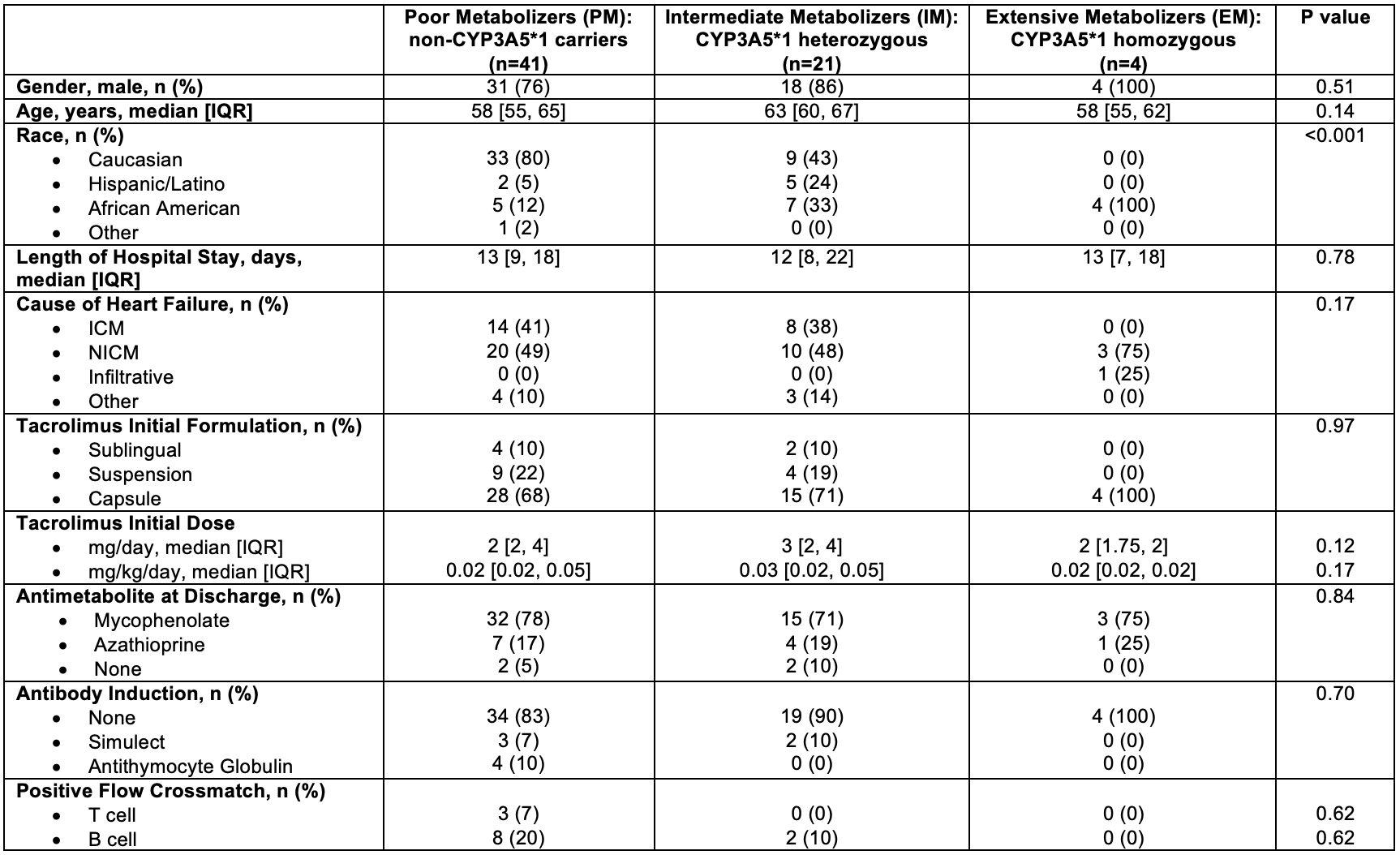Cyp3a5 Extensive Metabolizer Phenotype May be Associated with an Increase in Class 2 Donor Specific Antibodies and Antibody-Mediated Rejection
S. Mirza1, N. Wilson2, J. Van Zyl2, P. Nguyen2, T. Sam2, S. Hall2, M. Askar2, R. Patel2
1Texas Tech Univeristy Health Sciences Center Jerry H. Hodge School of Pharmacy, Dallas, TX, 2Baylor University Medical Center at Dallas, Dallas, TX
Meeting: 2021 American Transplant Congress
Abstract number: 152
Keywords: Calcineurin, Gene polymorphism, Heart transplant patients
Topic: Clinical Science » Pharmacy » Non-Organ Specific: Pharmacogenomics / Pharmacokinetics
Session Information
Session Name: The Metabolism Milleu: Updates in Pharmacokinetics and Pharmacogenomics
Session Type: Rapid Fire Oral Abstract
Date: Sunday, June 6, 2021
Session Time: 6:00pm-7:00pm
 Presentation Time: 6:10pm-6:15pm
Presentation Time: 6:10pm-6:15pm
Location: Virtual
*Purpose: Tacrolimus (TAC) metabolism is highly dependent on CYP3A5, yet there is limited data on the effect of CYP3A5 genetic polymorphisms in heart transplant recipients (HT). The purpose of this study is to identify associations between CYP3A5 phenotypes and weight-normalized TAC dose at therapeutic level (TL), time to TL, time to stable TL, donor specific antibodies (DSA) development, and rejection.
*Methods: We conducted a retrospective, single center review of HT transplanted 12/2018 to 08/2020. Patients were excluded if they were started on extended-release TAC, received combined organ transplant, or discharged on medications that significantly interact with TAC. TL was defined as 8-15 ng/mL and stable TL as 3 consecutive TLs. Patients were grouped by non-CYP3A5*1 carriers (poor metabolizers, PM), *1 heterozygous (intermediate metabolizers, IM), and *1 homozygous (extensive metabolizers, EM). If the patient was on sublingual TAC, the dose was reported as two-fold. All patients were on fluconazole 100 mg daily. Overall differences between metabolizer groups were assessed using Kruskal Wallis and Jonckheere Trend tests if continuous, and Chi-Square, Fisher Exact, or Cochran-Armitage Trend tests if categorical. Two group comparisons were made with Wilcoxon Rank Sum, Chi-Square, or Fisher Exact tests.
*Results: Of 66 HT analyzed, 41 were CYP3A5 PM, 21 IM, and 4 EM. First therapeutic TAC doses were significantly higher in the EM and IM compared to the PM (Fig. 1A). The stable therapeutic TAC dose was significantly lower in the PM group when compared to the IM and EM (Fig. 1B). Time to TLs were similar in all groups, however a trend towards longer time to stable TL in EM was observed (Fig. 1C). Additionally, there was a trend for a higher rate of Class 2 DSA (DSA-C2) and AMR in EM (Fig. 1D).
*Conclusions: We observed higher incidence of DSA-C2 and AMR in the EM group that might be related to prolonged time to stable TL. Thus, CYP3A5 phenotype testing may help identify HT who would benefit from increased DSA monitoring. These data warrant further exploration in larger cohorts.
To cite this abstract in AMA style:
Mirza S, Wilson N, Zyl JVan, Nguyen P, Sam T, Hall S, Askar M, Patel R. Cyp3a5 Extensive Metabolizer Phenotype May be Associated with an Increase in Class 2 Donor Specific Antibodies and Antibody-Mediated Rejection [abstract]. Am J Transplant. 2021; 21 (suppl 3). https://atcmeetingabstracts.com/abstract/cyp3a5-extensive-metabolizer-phenotype-may-be-associated-with-an-increase-in-class-2-donor-specific-antibodies-and-antibody-mediated-rejection/. Accessed December 27, 2025.« Back to 2021 American Transplant Congress


